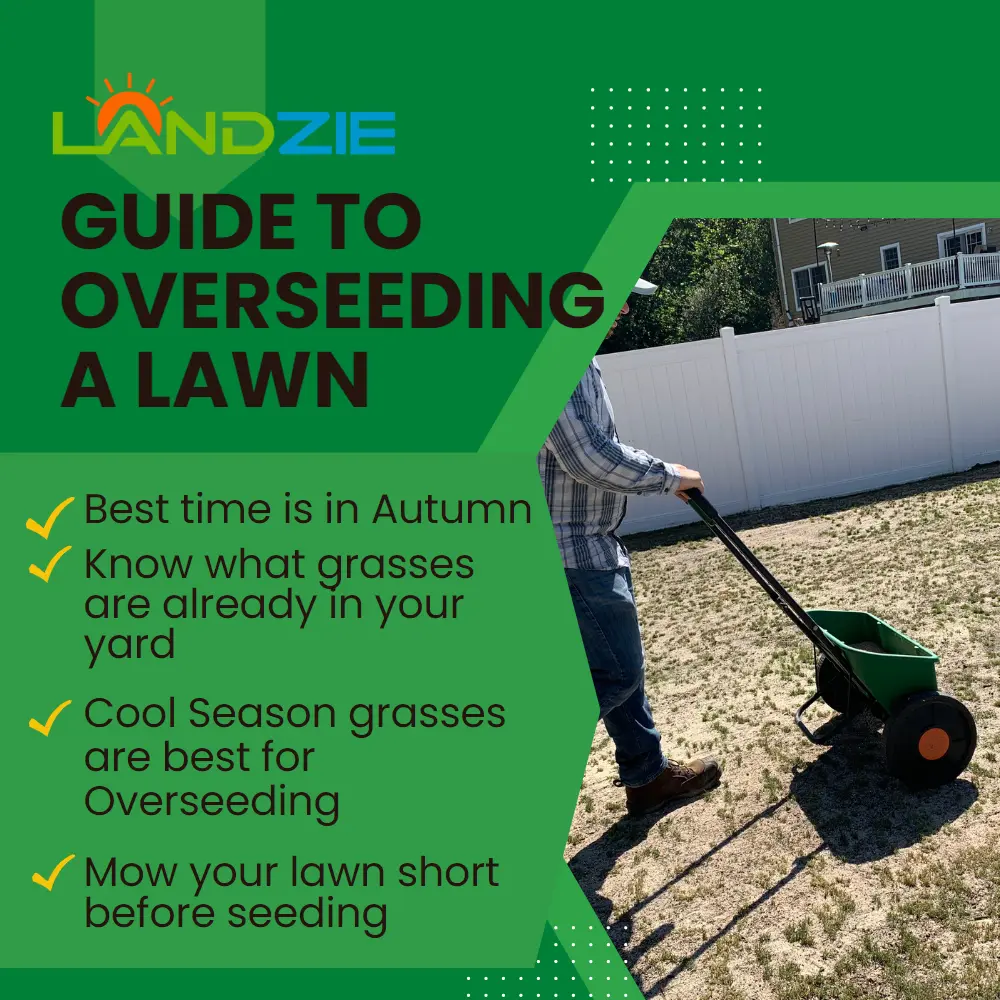Overseeding is the process of adding grass seed to an existing lawn. This helps improve its appearance and health. If you want a lush, green lawn, overseeding is essential. Follow this guide to learn how to overseed a lawn properly.
Why Overseeding is Important
Overseeding helps fill in bare spots and improves lawn density. It also introduces new, resilient grass varieties. These varieties are more resistant to diseases and pests. Overseeding also helps your lawn recover from stress caused by weather or heavy foot traffic.
When to Overseed Your Lawn
The best time to overseed depends on your grass type. For cool-season grasses, early fall is ideal. This gives the grass time to establish before winter. For warm-season grasses, late spring is best. This allows the grass to grow during the warm summer months.
Materials You Will Need
- Grass seed
- Lawn mower
- Rake
- Seed spreader
- Water
- Fertilizer
- Topdressing (optional)
Step-by-Step Guide to Overseeding a Lawn
Step 1: Mow Your Lawn
Start by mowing your lawn. Cut the grass shorter than usual. This allows the seeds to reach the soil. Collect and remove any grass clippings.
Step 2: Rake The Lawn
Use a rake to remove thatch and debris. Thatch is a layer of dead grass and roots. Removing it helps the seeds reach the soil. Raking also loosens the soil, making it easier for seeds to germinate.
Step 3: Choose The Right Grass Seed
Select a grass seed suitable for your lawn. Consider your climate and soil type. Choose a high-quality seed for the best results.
Step 4: Spread The Grass Seed
Use a seed spreader for even distribution. Follow the recommended seeding rate on the seed package. Spread the seed in two directions for better coverage.
Step 5: Fertilize The Lawn
Apply a starter fertilizer to help the seeds grow. Follow the instructions on the fertilizer package. Be careful not to over-fertilize, as this can harm the grass.
Step 6: Water The Lawn
Water the lawn immediately after seeding. Keep the soil moist until the seeds germinate. Water lightly but frequently to avoid washing away the seeds.
Step 7: Apply Topdressing (optional)
Topdressing is a layer of compost or soil. It helps protect the seeds and improves soil quality. Apply a thin layer if desired.

Credit: landzie.com
Aftercare Tips
Proper aftercare is crucial for successful overseeding. Follow these tips to ensure your new grass grows healthy and strong:
- Avoid heavy foot traffic on the lawn for a few weeks.
- Continue to water the lawn regularly.
- Gradually reduce the frequency of watering as the grass grows.
- Mow the lawn once the new grass reaches 3 inches in height.
- Fertilize the lawn again after six weeks to promote growth.
Common Mistakes to Avoid
To ensure your overseeding efforts are successful, avoid these common mistakes:
- Skipping the raking step. This prevents seeds from reaching the soil.
- Using too much seed. This can lead to overcrowding and weak grass.
- Watering too much or too little. Both can harm seed germination.
- Not protecting the seeds. Birds and wind can carry them away.
- Ignoring aftercare. Consistent care is essential for new grass.
Frequently Asked Questions
What Is Overseeding A Lawn?
Overseeding a lawn is the process of planting new grass seeds into existing turf without removing the old grass.
When Is The Best Time To Overseed?
Early fall or spring are the best times for overseeding. Cooler temperatures and rain help seeds establish.
How Much Seed Do I Need?
Use about 4-5 pounds of grass seed per 1,000 square feet of lawn. Check the seed package for specifics.
Do I Need To Aerate Before Overseeding?
Aerating your lawn before overseeding helps seeds make contact with the soil, increasing germination rates and overall success.
Conclusion
Overseeding a lawn is a simple yet effective way to improve its health and appearance. By following these steps and tips, you can achieve a lush, green lawn. Remember to choose the right time, materials, and grass seed for your specific needs. With proper care, your lawn will thrive and become the envy of your neighborhood.
FAQs
| Question | Answer |
|---|---|
| How often should I overseed my lawn? | Overseed your lawn once a year for best results. |
| Can I overseed without raking? | Raking is essential to ensure seeds reach the soil. |
| What type of grass seed should I use? | Choose a seed suitable for your climate and soil type. |
| How long does it take for new grass to grow? | Grass seeds usually germinate in 7-21 days. |
| Is it necessary to fertilize after overseeding? | Yes, fertilizing helps promote healthy growth. |

Credit: www.youtube.com
